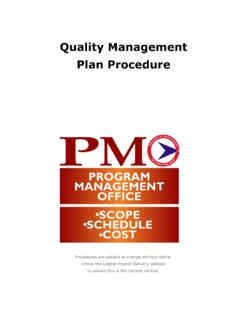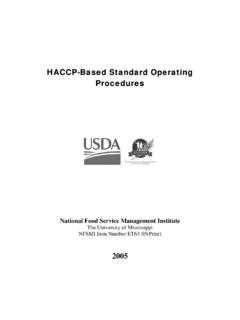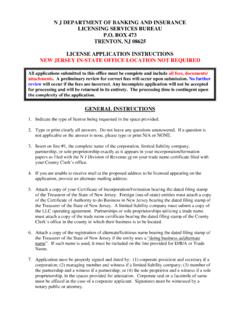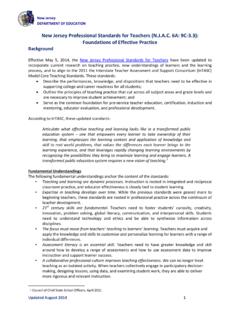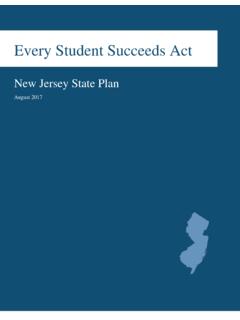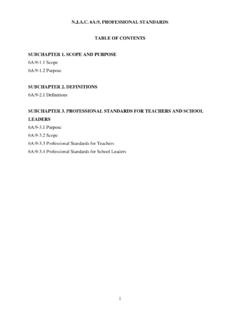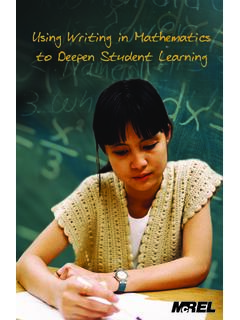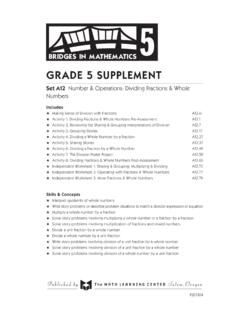Transcription of Approaches to Learning: Kindergarten to Grade 3 Guide
1 Kindergarten to Grade 3 GuidePPROACHES TO LEARNINGAAM arilou Hyson, , New Jersey Department of EducationApproaches to Learning, Kindergarten to Grade 3 GuideTABLE OF 1 EPPIC Skills: Core Expectations for Approaches to Learning, Kindergarten to Grade 1 What Are Approaches to Learning ?.. 3 Approaches to Learning, Cognitive Development, Social-Emotional Development, and SEL ..5 Why Are Approaches -to-Learning Competencies So Important for Children in K-3?.. 6 How Do Teachers Support the Growth of EPPIC Skills?.. 7 Approaches to Learning Components, Child Behaviors, and Teacher SupportsComponent 1: 2: Planning and 3: Initiative and and Final Yes-But and AAn Annotated Example: Opportunities for EPPIC Skill Development Within a K-3 Curriculum BPromoting EPPIC Skills with Remodeled CIncluding Approaches to Learning in K-3 PlanningTools to Adapt and to Learning, Kindergarten to Grade 3 GuideINTRODUCTIONAs a teacher in Kindergarten and the primary grades, you know that children s progress dependsgreatly on their motivation, interest, persistence, and ability to plan their work and manage theiremotions.
2 Just as New Jersey educators are guided by standards in areas like literacy and mathematics,expectations are needed for the critically important domain of Approaches to Learning. This Guidedescribes each of the core expectations and indicators; defines Approaches to Learning and explains howthese competencies connect with other aspects of development; describes why Approaches to Learningcompetencies are so important for K-3 children; gives you Grade -by- Grade examples of how childrendemonstrate these competencies; and lists many examples of ways that you can support children s EPPIC skills: engagement in learning, their planning and problem - solving , and their initiative and creativity. You may notice that the K-3 Approaches to Learning or EPPIC Skills are similar to but not exactly thesame as New Jersey s Approaches to Learning standards for birth to age 3 and preschool.
3 The K-3standards are also organized somewhat differently than Approaches to Learning in the few other statesthat have K-2 or K-3 standards in this domain. All the important aspects of Approaches to Learning arehere, but the expectations and indicators are organized to be (a) easy for teachers and administrators tounderstand and remember only 3 expectations with a few indicators under each, as compared with asmany as 5 standards and many more indicators in some other states and (b) easily aligned with NewJersey s K-3 content standards and curriculum Approaches to Learning for K-3 Students:What s Here to Help YouThis Guide has many features intended to help K-3 teachers provide children with what theyneed to be successful learners, using the EPPIC skills of Engagement, Planning and problem solving ,and Initiative and Creativity.
4 At various places in the Guide , you will find: Vignettes illustrating the importance of Approaches to learning in the lives and learning ofindividual students. What s So Important About .. ? 3 boxes, each of which briefly explains the importance ofone of the components of Approaches to Learning. Yes, But .. boxes with questions or concerns that might be raised by administrators,colleagues, or families with answers you can use. Examples of Remodeled Lessons that continue to strengthen children s competence in specificcontent standards and curriculum areas while at the same time promoting skills in the threecomponents of Approaches to Learning. EPPIC child behaviors, Grade -by- Grade : Examples of children s demonstrations of competence ineach ATL component: Engagement; Planning and problem - solving ; and Initiative andCreativity.
5 Teacher supports, Grade -by Grade : Examples of specific ways that teachers can support growthin each ATL component. Research evidence that shows why ATL are so important for overall development and learning,AND how teachers everyday supports can strengthen each child s to Learning, Kindergarten to Grade 3 GuideINTRODUCTIONEPPIC Skills: Core Expectations for Approaches to Learning, Kindergarten to Grade 31. Engagement: Demonstrates effortful, persistent engagement in learning Becomes involved in a variety of classroom activities Sustains attention despite distractions Persists in activities2. Planning and problem - solving : Demonstrates the use of planning and problem -solvingstrategies to achieve goals. Indicators Plans work to accomplish learning tasks Uses varied, flexible strategies to deal with problems Shows appropriate self-regulation and resilience in the face of challenges3.
6 Initiative and Creativity: Demonstrates initiative, independence, and creativity in new,challenging learning situations. Indicators Challenges self by trying out a variety of learning experiences Tries to broaden and deepen own learning Finds new connections across different ideas and learning tasks2 Approaches to Learning, Kindergarten to Grade 3 GuideWhat Are Approaches to Learning ?A Tale of Three ChildrenWe begin this Approaches to Learning Guide with descriptions of three children, Marta, Joe, andTaniesha. We meet them in the first weeks of their new school year. Perhaps their stories, and theirchallenges, will sound familiar. In the years from Kindergarten through Grade 3, children are expected to develop competence inacademic areas: language and literacy, mathematics, science and technology, and social , these vignettes show that academic competence needs strong support from other areas ofchildren s development.
7 Marta, Joe, and Taniesha all have the potential to be capable young learners, buteach of them has difficulty becoming deeply engaged, planning and following through, or exercisinginitiative in learning and creative thinking. Without these competencies, their academic skills are unlikelyto develop as well as they might, and their motivation and enthusiasm for learning are unlikely to grow. Martahas just begun first Grade . Her family has recently moved from Mexico, and Marta is stilllearning English. She has already made friends in the class and loves playing with them in thedramatic play area and doing anything with markers and crayons. Although her teacher Ms. Abel spreliminary assessment indicates that Marta already has many competencies to support languageand literacy development in her home language and in English, so far Marta has tried to avoidinvolvement in most of the class s literacy-related activities.
8 She seems to have difficulty payingattention if something more interesting presents itself. If she participates, she usually gives upquickly, saying that she doesn t know the answer, cannot do the activity, or is too tired to keepworking. Joeis a third grader with an eager attitude. Every day he comes to class with a big smile and Hello! --ready to jump into whatever Mr. Kennedy has planned. The problem is that he doesn t thinkbefore he acts. For example, the class is beginning to become involved in an in-depth project1ontransportation in their city, integrating literacy, math, and social studies. During extended periods ofthe day, small groups work in learning centers or worksites, each with a different specific focuswithin the transportation theme. His teacher encourages the children to choose where they willspend their time, but Joe tries to do everything at once and then becomes frustrated when his too-ambitious plans don t work out well.
9 As a result, his work, although showing great potential andcreativity, is never well-organized and seldom completed. Tanieshahas very strong academic skills compared to many of her Kindergarten classmates, atleast at this point in the year. Her teacher, Ms. Henry, finds that she has few problems completingliteracy and math activities correctly. She follows directions and tries to help others who may bestruggling. However, Taniesha seldom takes the initiative, even when choices are offered. Most of thetime, she sticks to what she already knows and always waits for her teacher to give directions. Whenit s time for learning centers, Taniesha gravitates toward a few where she feels comfortable. In class,Tanisha doesn t ask many questions, but when she does her questions are factual. She rarely tries toexplore new ideas or new ways of using information and detailed examples of project work, see the NJ DOE s First, Second, and Third Grade Implementation to Learning, Kindergarten to Grade 3 GuideWhat Are Approaches to Learning ?
10 Different names for these competencies, but agreement that they are havecalled these competencies by different names. Here we call them Approaches to Learning, a term that hasbeen used by many states. In this Guide we also use the acronym EPPIC Skills to make these corecompetencies easier to remember. Starting in the 1980s, experts identified Approaches to Learning as oneof the key areas of school readiness, along with preschoolers physical, cognitive, social and emotionaldevelopment. Some researchers have used the term learning behaviors, both for preschoolers and olderchildren. Other writers have used phrases like executive functions, habits of mind, grit, non-cognitiveabilities, and soft skills to describe these characteristics in the children s lives. In New Jersey, many of theseskills are represented in the New Jersey Career Ready practices( ) and have been identified as essential by New Jersey sbusiness community ( source/ ).
